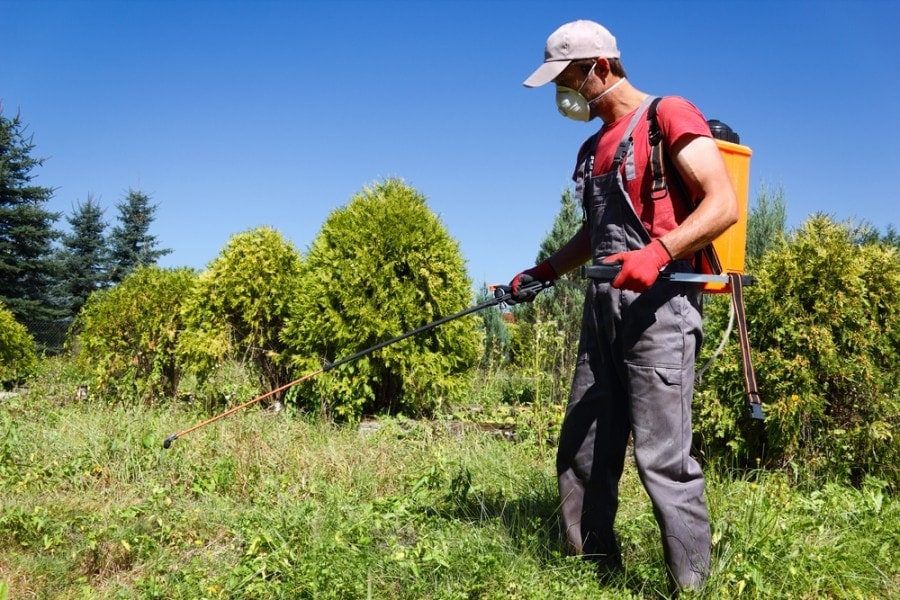When Is the Best Time to Spray Weed Killer? (Seasons, Weather & Time of Day)
-
- Last updated:


Regardless of how much we fight off weeds, they make a comeback. It can feel like we’re in the fight alone, and the weeds have something especially against us. Weeds are a problem for gardeners across the globe, and although they have the option of fertilization and irrigation, many people choose to spray weed killer.
Since that’s the case, we must consider the best time of the year to spray. What about specific climates or times of the day? The best time to spray weed killer is usually spring, but there are also safety issues around our home that we have to consider.

Before You Spray
We need to understand how weed killers work before we spray. How does a sprayed weed killer kill the weeds but not grass or other plants? Weed killers interfere in the growth of weeds by blocking protein production or destroying root formation. Herbicides aren’t as dangerous to people as pesticides, but we need to spray weed killers with caution.
Pre- and Post-Emergence Herbicides
We can use pre-emergence herbicides on an established lawn to disrupt the weed life cycle, especially for summer weeds. Pre-emergence herbicides examples are benefin and dithiopyr. Time the spraying of weed killer before weeds germinate, which is usually in early spring. Then, we can reapply the week killer 8 weeks after the first spraying.
For post-emergence herbicides, we can use glyphosate chemical to kill weeds by absorbing it into the plant tissue. Glyphosate-based chemicals achieve the best results when applied to young weeds.
Safety Issues Around the Home
Not only should we protect ourselves when spraying weed killer by wearing long sleeves, gloves, and goggles, as well as using a respirator and protective headgear, but we should also protect others. We need to read the label to know how long we must stay out of the treated area, but before that, we need to keep pets indoors.
Also, we need to keep children away from the sprayed area before and after, so they should be inside during the spraying and avoid the area for the duration specified on the label.
Tips & Tricks
Spraying by the Seasons
Although we may get attacked by weeds all year round, we need to strategize about when to spray weed killer to get the optimal effect. Let’s go through our strategy per season.
Winter
Weed killers work best during warmer conditions, but that doesn’t mean we can’t apply them during winter. Then, we have to ensure that we spray during the middle of the day. The chemicals may lose their efficacy if allowed to freeze overnight.
Summer
If we’re going to spray in summer, we need to do it at the end of the season. By treating weeds at the end of summer, we’ll minimize the problem for next spring. We should use an herbicide that kills various pest grasses and apply it in the late morning or early afternoon. The spray may evaporate in the heat of full sun.
Fall
This is a great season to spray weed killer because it’s when weeds are most vulnerable. By spraying post-emergent, weeds will struggle to survive winter. We should apply two treatments in October, two weeks apart. If they don’t wilt immediately, we need to be patient until spring, when we’ll see that most of them won’t return.

Spraying by Time of Day
Not only are weeds more prominent during specific seasons, but they also have peak times during the day when they flourish if we don’t take care of them.
Cold Climate
It’s pointless to spray weed killer when there’s dew on the plants because the spray will become too diluted to be effective. Harsh winters are also pointless if the ground is frozen or covered in snow. If there’s no snow and the ground isn’t frozen, the best time is mid-day, with the sun out.
Temperate Climate
Since plants are least active from dusk until the following morning after sunrise, the ideal time to spray in a temperate climate is in the late morning or early afternoon.
Warm Climate
It’s best to treat when overnight temperatures are in the low 70s to 60s. Daytime temperatures should be in the mid-80s.
Weather Conditions
Weather has a significant role in the effectiveness of spraying weed killer.
Rain
Spraying a plant after the rain has fallen will dilute the weed killer and make it less effective, so we should ideally wait 24 hours for the plants to dry. If the region receives a lot of rain, we can use weed killers that are rainfast within 2–4 hours of spraying.
Wind
We need to minimize spray drift, which happens when herbicide blows to other areas of the yard during windy conditions and kills unintended plants. There’s no point in spraying when the wind is strong, so we must wait for it to calm down, which usually happens in the morning and at night.
Extreme Heat or Cold
Extremely hot or cold conditions won’t work because liquid evaporates before absorbing in extremely hot temperatures and freezes in extreme cold.
- Replanting: It’s important for us to know when it’s safe to plant larger plants so that they’re not negatively affected, meaning we need to provide enough time for the weeds to die and the herbicide to dissipate.
- Type of herbicide: We need to decide between granular or liquid herbicide. With granular, we don’t have to worry about drift; it sticks to plants better when there’s moisture. Liquid is more suitable for tougher weeds due to even coating.
- Don’t overtreat: It’s important that we follow label instructions for mixing and application so that we don’t damage the soil.
- Treating lawn: Mowing the lawn before spraying isn’t a good idea because we need to have the weed intact to apply the weed killer.

Conclusion
The best season to spray the weed killer is in spring or fall. It works best in warm temperatures but not when it is sweltering because the liquid evaporates or is extremely cold so that it freezes. Spray the weed killer in early spring, then another application 8 weeks later. We can also do it in fall, with October being the best month, so the weeds don’t survive in winter. Two treatments that are 2 weeks apart in that month will create the optimal result.
Featured Image Credit: ninikas, Shutterstock
Contents


